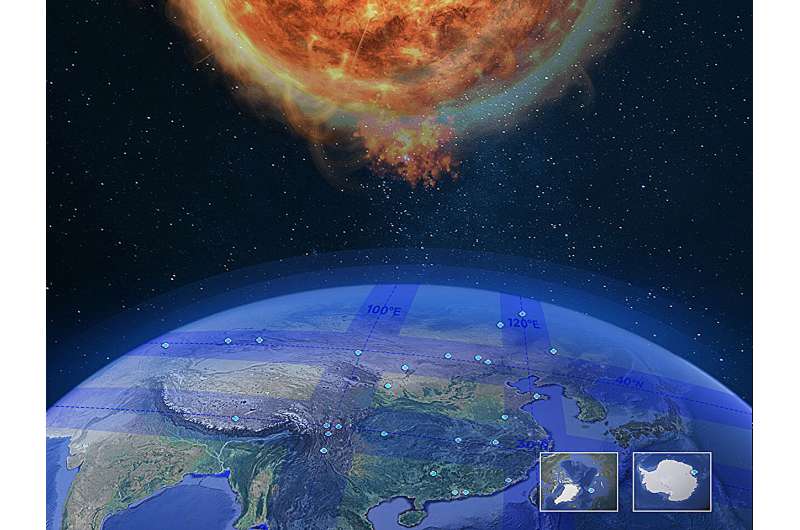This article has been reviewed according to Science X's editorial process and policies. Editors have highlighted the following attributes while ensuring the content's credibility:
fact-checked
peer-reviewed publication
proofread
From sun to Earth: A new network for comprehensive space weather monitoring

There's a lot going on between Earth's atmosphere and the sun. Accurately forecasting conditions in this area of space is challenging but critical to the safety of astronauts, satellites, and even ground-based systems such as power grids. Doing so requires using a combination of monitoring techniques to track specific aspects of the sun, solar wind, the ionosphere, and more.
Later this year, a new large-scale network is set to significantly enhance scientists' ability to watch and predict how events on the sun will affect Earth.
In the journal Space Weather, Chi Wang and colleagues introduce the Chinese Meridian Project (CMP), a comprehensive, ground-based space environment observation network that integrates data from about 300 instruments to monitor space weather as it travels from the sun to Earth's atmosphere.
The CMP is projected to provide continuous monitoring of multiple spatial layers of the solar-terrestrial space environment, enabling both more rapid detection and more accurate forecasting of events such as solar storms.
The CMP is organized around an architecture of "one chain, three networks, and four focuses," the authors write.
The "one chain" refers to a collection of optical, radio, geomagnetic, and other devices that monitor the chain of weather events that travel from the sun to Earth.
The "three networks" cover three areas closer to home: Earth's ionosphere, geomagnetic field, and middle and upper atmosphere. They include radar, lidar, and geomagnetic and ionospheric instruments based in China that observe each of these levels.
The "four focuses" are four locations: the poles, middle- and low-latitude regions in China, and the Tibetan Plateau. Here, specialized tools and monitoring facilities, including telescope arrays, magnetographs, radar systems, and an aurora spectrometer, will offer more detailed views of geomagnetic and atmospheric disturbances.
The network also includes data transmission and storage capabilities, as well as a system for analyzing and sharing data from the CMP with the international research community.
The CMP is expected to improve scientists' ability to gather data on the solar-terrestrial environment. This could enhance their ability to forecast events such as electromagnetic storms that imperil satellite networks and electrical grids.
More information: Chi Wang et al, China's Ground‐Based Space Environment Monitoring Network—Chinese Meridian Project (CMP), Space Weather (2024). DOI: 10.1029/2024SW003972
Journal information: Space Weather
Provided by Eos
This story is republished courtesy of Eos, hosted by the American Geophysical Union. Read the original storyhere.





















